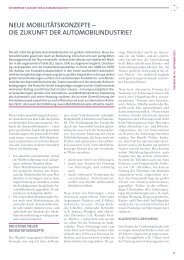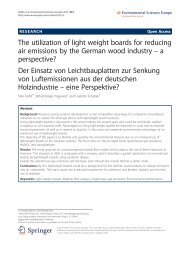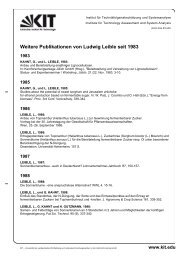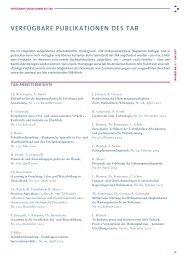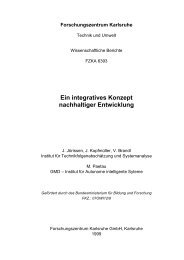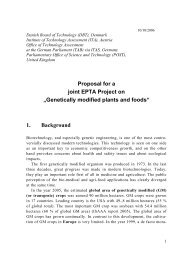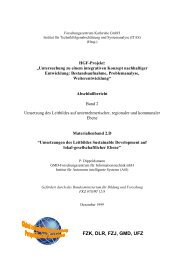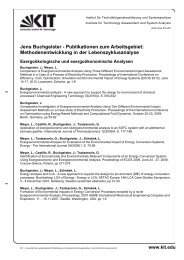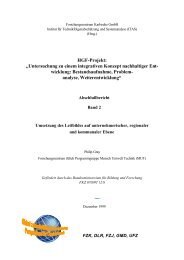Annex 4: Case study âOrganic Farmingâ - ITAS
Annex 4: Case study âOrganic Farmingâ - ITAS
Annex 4: Case study âOrganic Farmingâ - ITAS
You also want an ePaper? Increase the reach of your titles
YUMPU automatically turns print PDFs into web optimized ePapers that Google loves.
utilization of compost or precomposed manure more promising for the Tassa System. Reason<br />
is the reduced time span between the application of organic fertilizer and the sowing.<br />
Generally, combinations of different adopted techniques should be preferred instead of<br />
drawing the focus on one single approach. By accumulating different positive effects, an<br />
adopted set of approaches may has the potential to considerably increase the benefits of the<br />
production system [Kriegl 2001, p.186].<br />
4.1.2 The Double-Digging Method – an example of additional income creation for<br />
small-scale farmers in Kenya<br />
Market-oriented organic production in Kenya is, according to Bues’s distinction [2007,<br />
p. 11f], the main purpose of specialised large- and medium-scale farms, with the large-scale<br />
producers serving the international market. Medium-scale producers are characterized by<br />
producing for the national market. Nevertheless, the author also describes a mixed form of<br />
subsistence and commercial production, where small-scale farmers who achieve marketable<br />
surpluses or produce small shares of cash-crops also operate on the national market. The<br />
importance/scope of these market-oriented smallholders in Kenya can be estimated to be<br />
considerably high since small-scale farming is described by Omondi [2006 in Bues 2007,<br />
p. 6] to account for more than 85 % of the agricultural sector. Just like large-scale commercial<br />
farms, many of these smallholders are also organized in groups such as the Kenya Organic<br />
Farmers Association (KOFA), (founded as a national representative organisation)<br />
[KOAN 2005].<br />
Characteristics of the Double-Digging Method<br />
Double-Digging is a method of deep soil preparation in which the soil is loosened to a depth<br />
of 60 cm (2 feet) and fertilized with organic matter [Mundy 1998]. This technique implies the<br />
inversion of the soil by removing the topsoil of one segment using it as subsoil for an adjacent<br />
segment of a seedbed of about 150cm width. Finally, the whole seedbed consists of topsoil<br />
covered by the former subsoil. Compost incorporation is realized by mixing it with the topsoil<br />
used to fill the pits. The whole seedbed can be constructed either as a sunken bed for the dry<br />
season or as a raised bed for the rainy season in order to facilitate optimal water management.<br />
Under regular soil conditions, a repetition of the Double-Digging every 3 years is regarded as<br />
sufficient [Bues 2007, p.41; Mundy 1998].<br />
32



